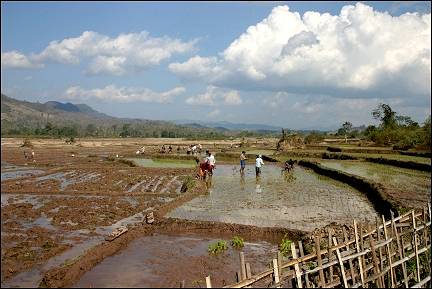

|
Bicycle trip from Pak Beng, a sandpath with guesthouses, along valleys and paddies to Muang Houn, with its two streets a larger town. Luang Prabang, with over 60 temples, is a mix of Laotian atmosphere and French grandeur. Via the karst mountains and the caves of Vang Vieng to Vientiane, the modest capital on the Mekong. The trip ends with a short stretch in Thailand.
Travelogue & photos: Gerrie & Aart Dijkzeul
This week we travel from the border crossing Chiang Khong in North Thailand via the Mekong river to Pak Beng. From there we will bicycle in northern direction to Udon Xai and to the east to Pak Mong. Then we'll go south to Luang Prabang, one of Laos' touristic highlights.
It's hard to imagine a stronger contrast within one week. For days we don't see a Western person and then, in Luang Prabang, they're everywhere. For several nights we sleep in guesthouses where we share the bathroom with Laotian truckdrivers and then all of a sudden we're in a fancy hotel in Luang Prabang.
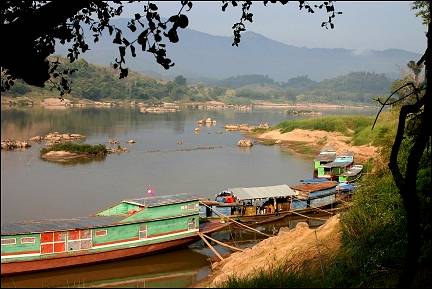
|
The alarmclock wakes us early. The owner of our guesthouse overslept, so we have to hurry with our toast and coffee. The boat that will take us from North Thailand to Pak Beng in Laos doesn't wait for us.
Eventually we arrive at the harbor on time. The "harbor" is a slippery, steep, sandy slope. But first a passport check here and a passport check there. Three times. Yes, those Laotians are thorough. It seems they spell every letter in the red book (Dutch pasports have a red cover, ed.). We change dollars for kip, the Laotian currency. 100 dollars buy us a million kips in denominations of 500 kip. A weekend bag full of money.
By nine we're on the boat. The bicycles are on the roof; it breaks our hearts to see how our darlings are handled. The boat is a kind of long, narrow barge with a roof. It's been painted apple green and as a finishing touch there are pink curtains against the sunlight. Left and right there are about thirty benches that each have room for one and a half butt. The crew assigns two to each bench. Passengers keep boarding, until tourists protest and say it's becoming too dangerous.
By ten we leave. It's a long journey, but not unpleasant. The view is gorgeous. Navigating the Mekong requires a lot of skill from the helmsman. In many places rocks stick out of the water. We hope the helmsman knows what's under water. To keep the boat floating, two boys are busy during the whole trip to scoop up water from the bilge of the boat and throw it overboard. Probably cheaper than a pump.
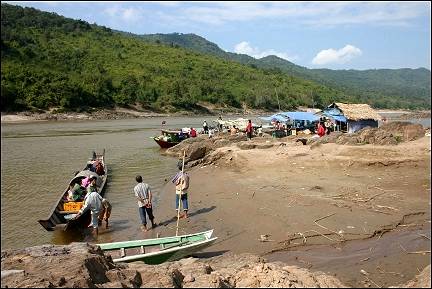
|
After three hours we stop. The boat empties. Within seconds we're watching tens of male backs, scattered on the sloping bank. The women find spots behind the rocks.
We continue our trip and at 5 PM we dock in Pak Beng, a village with only one street, a sandpath. To the left and right there are some stalls. Most of the buildings are guesthouses. The village's source of income is from tourists who take the boat to Luang Prabang (another 7 hours) and who have to spend the night somewhere. We are the only ones who don't board the boat again the next day.
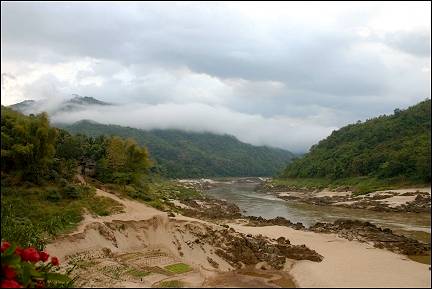
|
If we're lucky, the village has electricity from 6-10 PM. We're out of luck. Time and again we have to light candles. Romantic, but it also feels unreal.
Next morning we mount our bikes around 8:30 AM. The boat to Luang Prabang has just left. We have Pak Beng to ourselves. From the description of the trip we gather that the road to Udon Xai is not great, but that the landscape is beautiful.
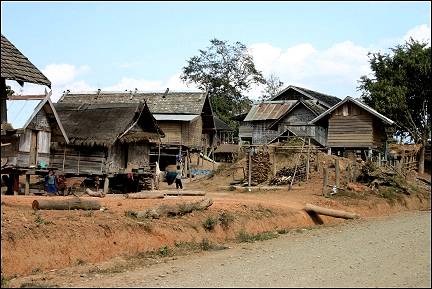
|
Neither qualification is exaggerated. The road is a kind of gravelpath; not one, but all 65 kilometers to Muang Houn, where we'll spend the night. Bumping and shaking; moving kidneys. The upside: there are very few cars. Just a pick-up truck every now and then.
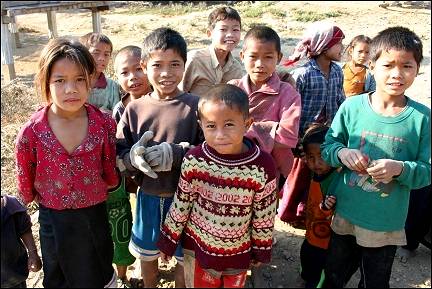
|
The landscape is beautiful. Hills and in the valleys some agriculture. The villages we pass by consist of 10-30 huts, made of wood, bamboo and reed. No electricity, no running water.
Plenty of kids and pigs. No pampers: the little children run around naked.
Some of the older people wear traditional clothes, which are different in every village, that is, for every tribe. There are many mountain tribes here. Women and children carry bundles of wood, men saw treetrunks into planks. They dry and process reed. Generally everyone is busy.
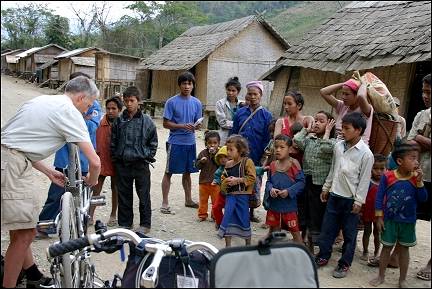
|
In every village the same ritual. When someone sees us approaching, we hear "falang" (stranger) and before we have reached the village, there is a welcoming (and parting) committee that greets us with "Sawaay-di" (good day). They don't know the word "hello"; probably because they don't have tv.
In one of the villages we ride too fast and the gravel punctures a tire. We take off the bags, turn the bicycle upside-down and fix the tire. Before we even have removed the bags, the whole village has gathered around us.
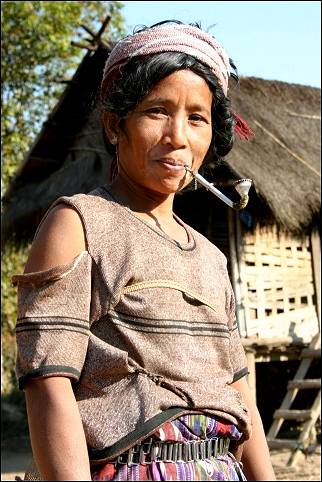
|
Women breast-feeding babies, men with children on their backs in a sling (we see that often). Everyone stares in amazement at what we're doing. Not for a moment, but for a whole hour. Fixing the tire isn't going too well.
But also when we stop to take a look or take pictures, we are surrounded by groups of people within moments.
There are no places where we can buy food on the road sides. Luckily, this morning we bought fried rice-filled dough balls. Around 1 PM we eat them while watching paddies where rice is being planted.
It's wonderful to watch: the mud when the fields are levelled, then groups of women planting the rice and, after everything has been done, the mirror-like water with fresh green rice plants sticking their heads above the surface.
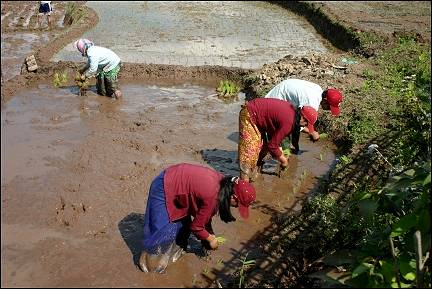
|
The fact that the paddies are at different levels (terraces), makes the view even prettier. The only difference with the traditional pictures from geography textbooks is that the women who plant the rice are not wearing pointy rice-straw hats, but baseball caps.
Muang Houn, where we arrive in the evening, is a somewhat larger town - it has two streets - with some stone houses. There is electricity and a guesthouse where we rent a room for 20.000 kip (1.5-2 euro). It's not very fancy: the mattress doesn't deserve that name, we can feel the planks of the bed through it. To reach the bathroom, with cold water from a mandi tank, we have to walk through the living room of the family who manages the guesthouse and its store.
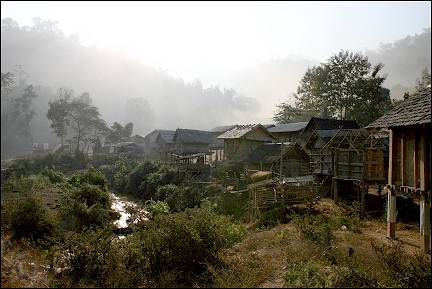
|
Next morning we rise early. All over the village people are sitting around campfires to warm themselves and make breakfast. The air is a strange mix of dust, fog and smoke.
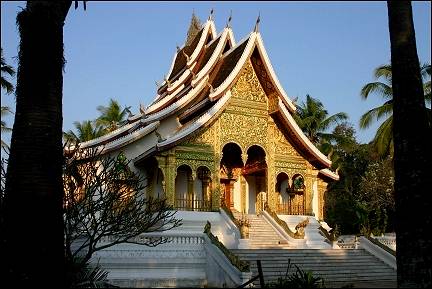
|
Four days long we keep bicycling. We enjoy it so much. Especially when after one and a half day the road improve. Climbing to an altitude of 1500 meters is a piece of cake for us now. Especially because the climb isn't that steep.
And then we arrive in Luang Prabang. It's a mix of Laotian atmosphere, French grandeur and tourism. It has a strong third-world shop feel to it. We visit some of the over 60 temples, talk with monks and spend more time in bed than usual to overcome the effects of eating bad food. Could that have been in the restaurant where we saw rats?
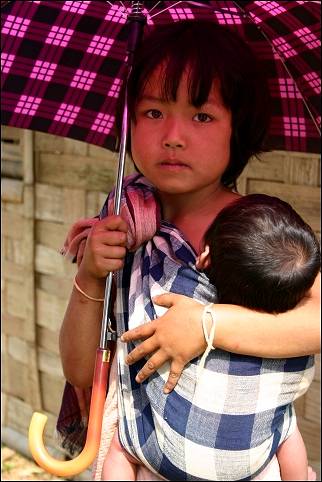
|
As soon as our tummies and intestines allow it, we go out. Southward to Vang Vieng and Vientiane, the capital of Laos.
Our route leads from Luang Prabang to Vang Vieng first. The counter says 200 kilometers, but it feels longer. The whole way we bicycle on the main traffic thoroughfare of Laos, Route 13. A neatly asphalted, one-and-a-half-lane road, where we meet more pigs than cars. Only once every 15 minutes or so a car passes us by. Usually a bus, sometimes an aid organisation's 4x4 or a truck
For two days the road goes up and down from 600 to 1500 meters. It's enough to drive you crazy. When you've just reached the highest point, there's a 20 kilometer decline. That's not the problem, but twice a day climbing a 5-7 percent slope for 20 kilometers is a lot for us. Next time we should bring less books.
The views make up for a lot, though. The Lord of the Ring could have been shot here. Wooded slopes with rustling brooks and waterfalls. Later in the week mysterious landscapes with the fantastic shapes of karst mountains. The people and the villages remain the same: primitive and friendly. Every now and then we see, even in small villages, satellite dishes. There is electricity here.
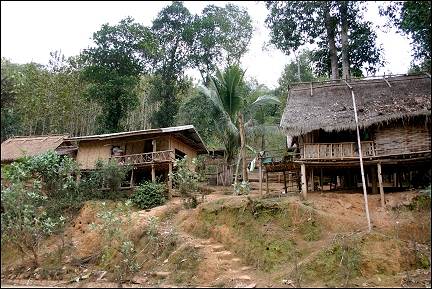
|
The guns we see before we enter Luang Prabang look less friendly. They are clearly meant to shoot more than rabbits. Apparently in the area between Luang Prabang and Vang Vieng there are sometimes skirmishes between ethnic groups and sometimes between rebels and the army.
There is a guy with a kalashnikov. A car stops, the window is rolled down and money is offered and accepted and there it goes again. We just say "sabaay-di" (good day). It is advised to travel only in groups and by daylight in this area. That works fine for us: we're a group of two and because of all the climbing we turn in before the sun goes down. Well, almost.
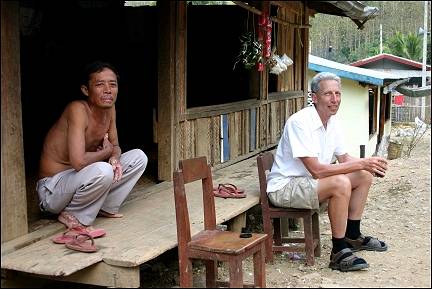
|
The guesthouses along this route aren't very different for the ones before. Except for the guesthouse in Muang Phu Khun, a tiny hamlet at an altitude of 1500 meters. After a taxing stretch we arrive, tired and sweaty, at a neat white-painted building.
But the cleanliness of the room and bathroom leave much to be desired. We accept it, though; we don't have a choice.
There is a boiler. We think: a nice warm shower. Ready for the treat we open the tap. Not a drop. Maybe the mains tap is shut. We get dressed and go to the manager. No "nam" (water). That's right, he gestures: no water. He walks with us and points to the oil drum in the shower, filled with dirty water. We can use this.
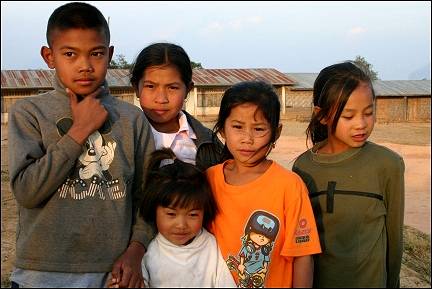
|
We don't think so. Washing ourselves with cold water is not a problem, but water that has been used before is. We walk to the hamlet to buy drinking water. There we see that none of the taps in the hamlet work. Everywhere are oil drums filled with water.
A watertruck comes to fill the drums regularly. The hamlet lies high up the mountain and during the dry season they have to get it from a (much) lower point. With three liters of drinking water and a water bottle for a shower we get ourselves clean.
When the sun sets a 6 PM it gets dark within half an hour. Life moves from outside to indoors. During our evening walk we peek inside houses. In a corner of the hut is a mattress for the whole family. In the center of the room a basket hangs from a rope: a cradle for the baby. Sometimes in a seperate hut, but often in the living room, burns an open fire: the kitchen. The smoke escapes via holes in the walls and the roof. It's a miracle that we hardly ever see a burned-down hut.
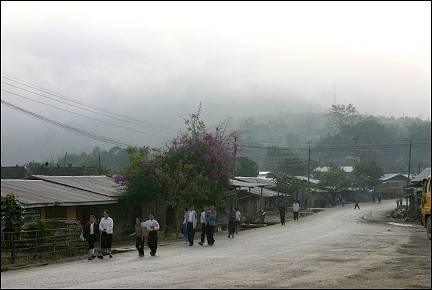
|
When we leave next morning, Phu Khun is one big cloud. Less than twenty meters view and a temperature well below 10 degrees Centigrade. It feels unreal. A pity we didn't bring gloves and shawls.
With our bicycle lights on (so the pigs can see us) we descend. Soon everything gets back to the way it should be: clouds above and people beneath. When the sun breaks through and another mountain before us, we soon forget the cold. In the lightest gear (1:1) the drops of fog are quickly replaced with drops of sweat.
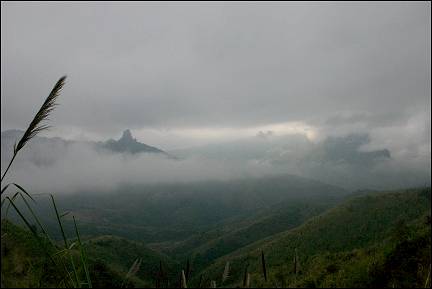
|
After four days we arrive in Vang Vieng. A shabby tourist town on a river. It's mostly guesthouses, restaurants and other facilities travellers need. Apparently it's easy to get opium here.
In any case we can replenish our food stock. After four days of noodle soup, bananas and chips (what a surprise that was when we found those in a hamlet in the middle of nowhere) we could use some tasty and nutritious food.
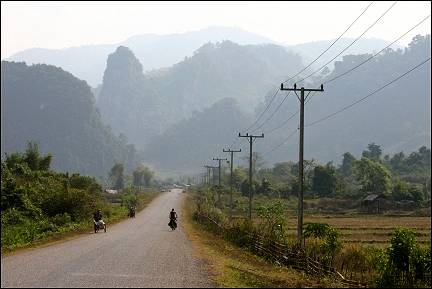
|
Probably we're not suited to be real world travellers. Noodle soup three times a day we really can't do. The same goes for rice (the alternative).
You have to grab a handful of rice from a reed basket and eat it with your hands. Better not think about it, especially because everyone puts their hands in the basket and when they've had enough they return the leftover rice to the basket.
We regain our strength and leave for Vientane tomorrow.
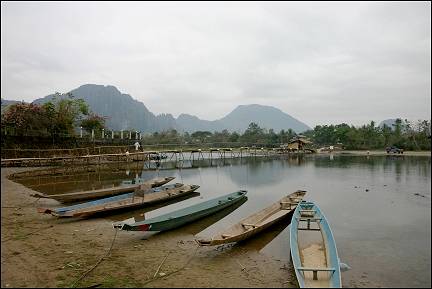
|
Saturday afternoon we visit one of the caves of Vang Vieng. We cross the river via a toll bridge. Private enterprise: a handy guy built a bridge of bamboo and planks and charges 3000 kip for using it.
Many locals don't feel like paying. They take their luggage and bicycles on their shoulders and cross the 75 meters wide river wading through the water.
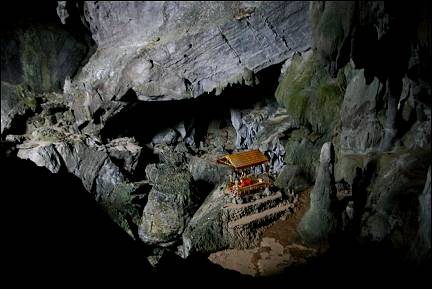
|
After 6 kilometers we meet the next smart Laotian in a shed where we have to pay 2000 kip to visit the cave. Two hundred meters climbing like a mountaingoat later we're there.
A hole in the mountain side gives access to a large cave with, what else, a lying Buddha. We look around us by the light of the flashlight we brought. We're afraid to enter the tunnels, who knows what we'd find there.
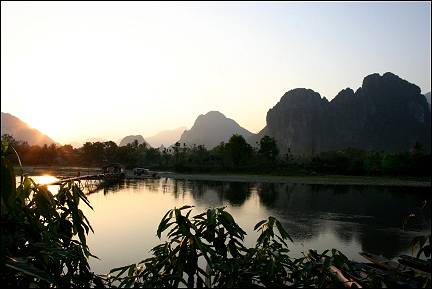
|
We're back in Vang Vieng just in time to watch the sun set behind the karst mountains, sitting on the bank of the river with a drink. A quarter of an hour later we see the bats leave the many caves of the mountains.
What a sight: dusk, red sky and swarms - literally tens of thousands - of bats going out to hunt insects.
We have dinner in the restaurant of the resort - a collection of huts in a park - where we spend the night. The owner gets his guitar and sings. No Laotian songs, but western sixties music of which he has three impressive anthologies. Later we find out he went to college in the USA, so that's why.
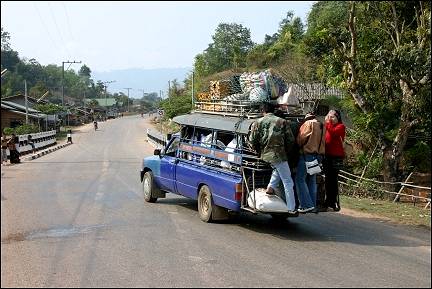
|
We join him and sing and play along. Guitar, first and second voice. Cozy. In the places we visit in this area there is much guitar playing.
Next day we continue our trip to Vientiane. Not in a straight line, but somewhat zigzagging. The steep climbs are over. Piece of cake for our trained calves. The first stretch ends in Hin Heup. It has a simple guesthouse but a beautiful river where we sit down.
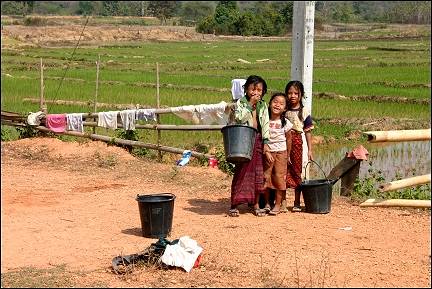
|
We read and watch the local population wash in the river. Everything very modest: the sarongs are lifted a little and the body gets washed under water.
The locals for their part stare at us. White legs that disappear in shorts are apparently - especially for the little boys - interesting. Unabashedly they lie on their bellies to find out where those legs meet.
Over the next days we see the landscape and the people change: flatter, large-scale rice cultivation and bigger houses. Sarongs are replaced with jeans and the numbers of mo-peds and cars increase. It's clear that we're approaching the capital.
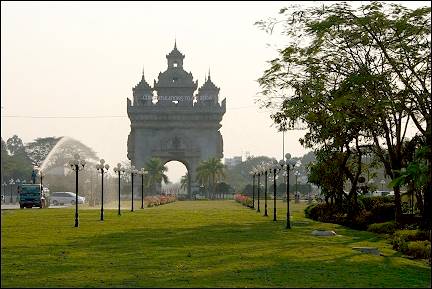
|
How do you imagine the capital of a country six times bigger than The Netherlands looks? Something like Amsterdam? Not even remotely. The French probably did their best to make something of it in their day.
The only things that remain from those times are some - mostly dilapidated - colonial buildings and a large avenue from the presidential palace to a triumphal arch built by the Laotians themselves in the 1960s.
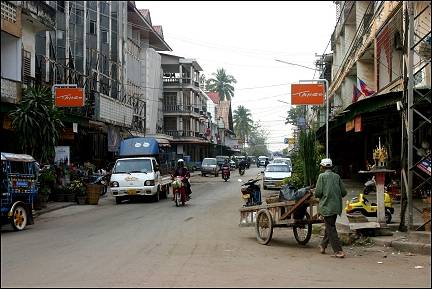
|
When the president or one of his guests (there is a conference of Asian countries in Vientane) wants to go out, the avenue is closed off from beginning to end and the armored cars race over the smooth concrete, escorted by police cars with flashing lights.
Along the avenue are also some ministries and embassies. The rest of the city is messy and seedy. The streets are paved, but along the sides, where the sewers are, are wide strips of sand and dust.
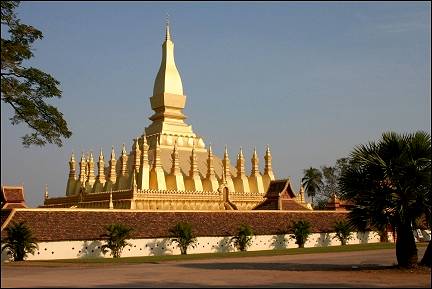
|
The city does not provide sidewalks, so house and store owners build their own. One high, the other low, so one has to pay attention. And before you know, you step into a hole under which the open sewer lies.
It's safest to walk on the road. There are no apartment buildings of other highrises; two or three floors is the maximum.
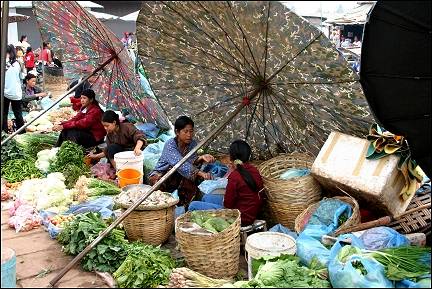
|
Vientiane is beautifully situated on the Mekong. In Europe there would be a promenade with palms and outdoor cafés. Here the banks look like a combination of the side of an irrigation canal and an industrial zone. It's low tide and a big sandplain appears above the water.
The market is a colorful collection of small "fancy" stores in a large hall. Lots of clothes and cd's. Also small shops with gold jewelry. The daymarket is much more fun: colorful vegetable stalls, meat and fish. Everything from pork chops to pigs' heads.
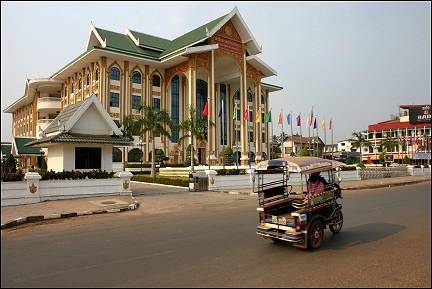
|
Thursday night we visit the cultural center of Vientiane. A Cuban ballet dancer performs. Entrance is free. So what does one do, being Dutch? The performance begins at 7:30 PM, says the poster. Of course it starts a little after eight.
First we enjoy a half hour long introduction by a Laotian and the Cuban embassador with simultaneous interpretation. And then it begins.
We expect exciting Latin American music and dance, but no. The Lake of Swans with just the swan. Five minutes and it's over. It's followed by a karaoke performance, without subtitles and genre tear-jerker.
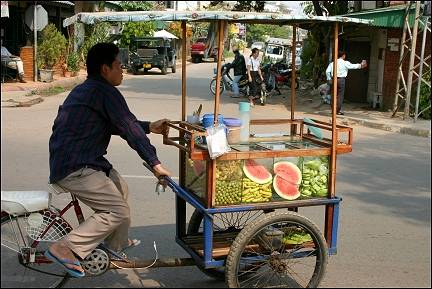
|
The choreography is limited to a waving hand here and there. MTV has its work cut out for it here. Luckily there's a large group of children in the hall, hundreds of them, who are entertaining.
Tomorrow we'll mount our bikes again after three pleasant and relaxing days. We'll cross the border with Thailand. A few more days of bicycling there and then it's over.
Vientiane-Udon Thani is - with some zigzagging - good for two days of bicycling. Our first stretch leads us along the Mekong for the largest part. Some roads are paved, some aren't. We were a little premature, cleaning our bikes in Vientiane. In no time at all they're covered in red dust again. The same goes for us.
From the number of temples and their goldpaint as well as from the number of stone houses we take it that tobacco, cabbage and black-eyed peas are profitable crops.
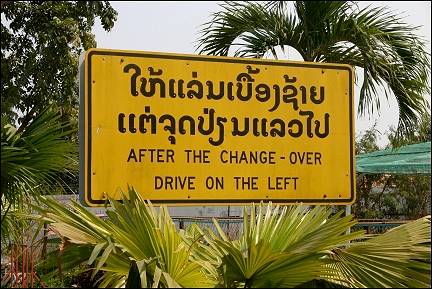
|
Via the Friendship bridge (donated by Australia to Thailand and Laos and as far as we know the only bridge over the Mekong) we ride to Thailand. A few stamps in our passports, changing from the right to the left side of the road and before we know we're in Nong Khai.
This part of Thailand is wealthy. Wide and smooth roads. Stores with all kinds of fancy merchandise and a hotel where one can order a masseur, beautician or hairdresser at any hour of the day. What more could one want?
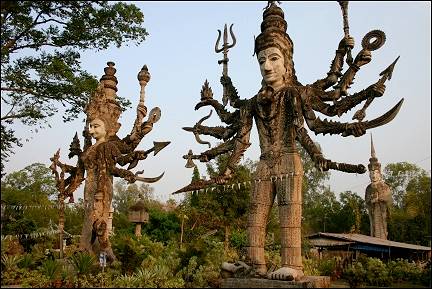
|
Before dark we quickly bicycle to a sculpture park. Three kilometers on the shoulder of the highway. The park has the most fantastic sculptures which all have something to do with Buddhism or Hinduism.
There are Buddhas tens of meters high. Snakes with seven heads, dancers with ten arms, an elephant with three trunks who - almost like the pied piper - has hundreds of stone dogs following him.
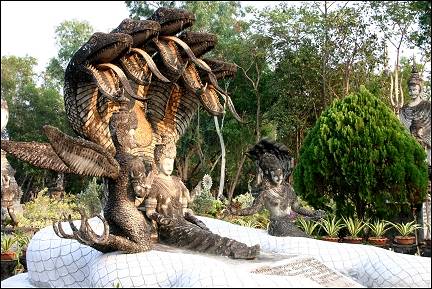
|
What it means or represents we don't know. If there is any explanation at all, it's in Thai. But that doesn't diminish the fun at all. It's beautiful and at the same time crazy. If we weren't already, we'd definitely become happy here.
Our last day of biking takes us to Udon Thani. We decide not to ride along the highway. This is our last opportunity to taste the atmosphere of Thailand's countryside and we don't want to miss that. So, instead of 50, we ride 95 kilometers. It's worth the extra drops of sweat.
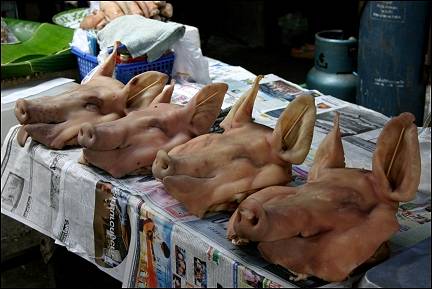
|
Udon Thani turns out to be a large and wealthy provincial capital. Nothing spectacular here. We wander through streets and markets, look at what passes by and read in a park. In the evening we eat at the nightmarket.
In contrast to Chiang Mai and Vientiane the stalls here are not catered to tourists. There are hardly any westerners. No handcrafts or pretty souvenirs, but vegetables, fruit, T-shirts and jeans. In tens of stalls brand rights are violated. Applying the Nike logo is a matter of brushing some paint in a template. Done while-u-wait.
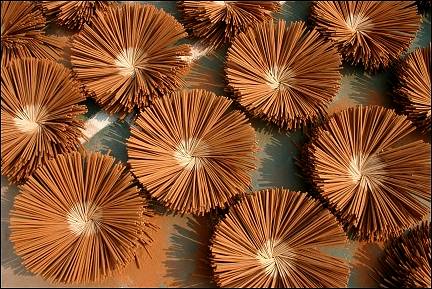
|
Karaoke is popular here too: tens of stalls sell dvds with karaoke music. The best is a covered part of the market with some fifty, sixty oversized phone booths.
In each booth is a tv and microphones and some youngsters who sing along with the music, sitting or dancing. We don't believe our eyes. We seriously consider introducing this phenomenon at home. Considering how popular Idols is there, there should be a market for this kind of thing in The Netherlands.
After almost 1800 kilometers bicycling, tomorrow we'll pack up our bikes and ourselves to go home. Let's see if we'll be allowed to enter The Netherlands, coming from this bird flu ridden region. We enjoyed our bike vacation.